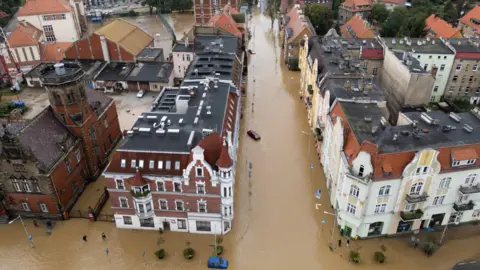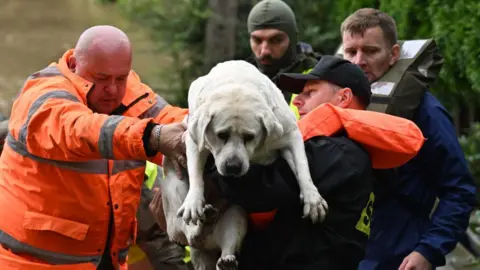 Reuters
ReutersThe death toll from the floods that hit central Europe over the weekend has risen, with more casualties recorded in the Czech Republic, Poland and Austria.
In the Czech Republic, one person drowned in a stream close to the town of Bruntal in the north-east of the country, while seven people are still missing.
Four people are known to have died in Poland, although a spokesman for the interior ministry said the precise cause of death was still to be determined in at least one case.
And in Austria, two people aged 70 and 80 died in the north-east of the country. One of them, a resident of the town of Höbersdorf, was apparently trying to pump water out of his apartment when he drowned, Austrian media reported.
Eight deaths were recorded over the weekend in Poland, Romania and Austria, where a firefighter was killed during a flood rescue operation.
Although conditions have stabilised in some parts of central Europe, others are bracing themselves for more disruption and danger.
In Slovakia, the overflowing of the Danube River caused flooding in the Old Town area of the capital, Bratislava, with local media reporting that water levels exceeded 9m (30ft) and were expected to rise further.
 Getty Images
Getty ImagesHungarian Prime Minister Viktor Orban said on X that he had postponed all his international obligations “due to the extreme weather conditions and the ongoing floods in Hungary”.
The highest rainfall totals have been in the Czech Republic. In the north-eastern town of Jesenik, 473mm (19in) of rain has fallen since Thursday morning – five times the average monthly rainfall.
Austrian Chancellor Karl Nehammer said the armed forces had been deployed to offer assistance to storm-hit regions. In St Polten, more rain has fallen in four days than in the whole of the wettest autumn on record, in 1950.
Polish Prime Minister Donald Tusk said one billion zloty (£197m) would be allocated for flood victims. He added Poland would also apply for EU relief funds.
Villages and town were submerged in eastern Romania. Emil Dragomir, mayor of Slobozia Conachi, told media that the flooding had had a devastating impact.
“If you were here, you would cry instantly, because people are desperate, their whole lives’ work is gone, there were people who were left with just the clothes they had on,” he said.
Thousands of people have been evacuted in Poland, including the personnel and patients of a hospital in the town of Nysa. Roads have been badly disrupted and train traffic was suspended in many parts of the country.
On Monday morning, the mayor of Paczków in south-west Poland appealed to residents to evacuate after water began overflowing in a nearby reservoir, endangering the town.
In other parts of Poland, however, water levels are now falling, according to local officials.
The mayor of Klodzko city, Michal Piszko, told Polish media the water had receded and the indications were the worst was now over.
Video footage from Monday morning showed that city centre streets which were inundated on Sunday were now water-free, although the footage also revealed the extent of damage done to the buildings.
More rain is expected throughout Monday and Tuesday in Austria, the Czech Republic and south-east Germany, where another 100mm (4in) could fall.
While it may still take days for the flood waters to subside, the weather will improve in central Europe from mid-week with much drier conditions.
Storm Boris will, however, now move further south into Italy, where it will reintensify and bring heavy rain. The Emilia-Romagna region is set to be worst hit, with 100-150mm (4-6in) of rain falling.
This could lead to some flooding in the region.

